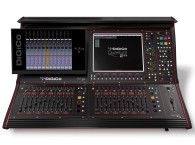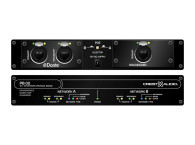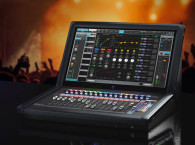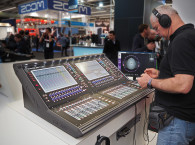Roland announced the M-5000C Live Mixing Console, the newest addition to the growing line of O.H.R.C.A.-based consoles from the Japanese brand with extended audio network support (O.H.R.C.A stands for “Open,” “High Resolution,” and “Configurable Architecture”). Measuring under 30” (74 cm) in width and weighing just 70 lb (32 kg), the compact M-5000C maintains the quality and many features of the flagship M-5000, making it ideal for theatres, churches, OB trucks/vans, touring or any application demanding power and flexibility in a small footprint.

Along with 96-kHz sampling rate support, the M-5000C has a 72-bit summing bus, newly designed discrete analog circuitry and redundant power supply. In addition to 16 inputs and 8 outputs on the console, the M-5000C also features two expansion interface slots that can accommodate REAC, Dante, MADI, Waves SoundGrid, and other XI-Series expansion cards.
 The M-5000C supports the flexible live sound workflow at the heart of Roland’s O.H.R.C.A. platform. Control includes a 12” color touchscreen; 20 channel faders in three groups; anchor points; DCA spills; multifunction knobs and buttons; and a user assignable section. Roland also confirmed that remote control software (Mac/Windows) will be available soon, extending the user interface beyond the built-in GUI, resulting in flexible organisation of critical pages or meters on external monitors.
The M-5000C supports the flexible live sound workflow at the heart of Roland’s O.H.R.C.A. platform. Control includes a 12” color touchscreen; 20 channel faders in three groups; anchor points; DCA spills; multifunction knobs and buttons; and a user assignable section. Roland also confirmed that remote control software (Mac/Windows) will be available soon, extending the user interface beyond the built-in GUI, resulting in flexible organisation of critical pages or meters on external monitors.The O.H.R.C.A. platform brings a new dimension of configurability to a live mixing console by providing a mix engine of 128 freely definable audio paths; open audio architecture supporting Dante, MADI, Waves SoundGrid, and REAC audio protocols; and audio delivery over video using SDI, DVI, and SFP cabling. Built-in REAC ports support seamless integration from the console for multi-track recording/playback, Roland M-48 personal mixers, and a plethora of I/O box choices to fit any need, all at high-resolution 24-bit 96 kHz.
Sales of the Roland M-5000 are picking up speed since the company confirmed availability of the XI-Dante, an XI-Expansion Interface card that extends the audio I/O capabilities of the M-5000 Live Sound Mixing Console with any other equipment supporting Audinate’s Dante. The new XI-Dante is one of seven expansion cards offered as part of the open architecture of Roland’s O.H.R.C.A. mixing platform.

The Dante digital audio transport protocol delivers multi-channel, low-latency, uncompressed audio over an Ethernet network. When used with the M-5000, the XI-Dante card offers a primary and a secondary port, plus a control port. It also supports 64 bidirectional audio channels at 48 kHz or 32 bidirectional channels at 96 kHz. Running digital audio through the M-5000 via the XI-Dante card eliminates common analog challenges such as interference from other electrical equipment, signal degradation over long cable runs, and more.
The XI-Dante card also expands the flexibility of Roland’s new V-1200HD Broadcast and Live Video Production Switcher by enabling it to operate in a wider range of broadcast and live production applications. When installed in a V-1200HD expansion slot, the XI-Dante card supports 16 bidirectional audio channels at 48 kHz.
proav.roland.com/ohrca/






